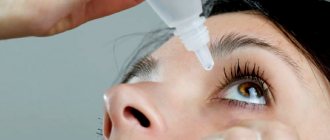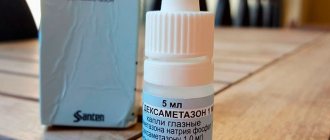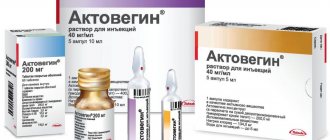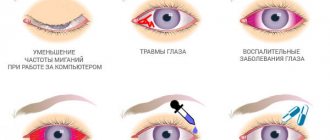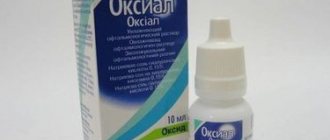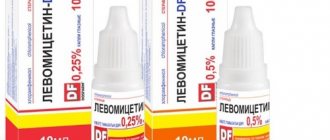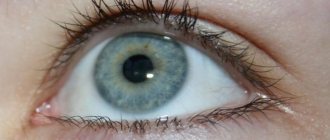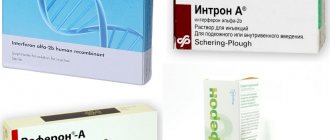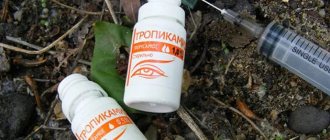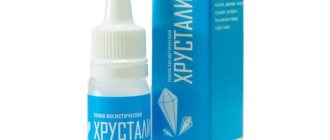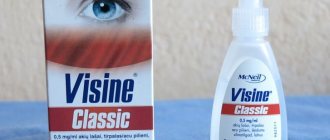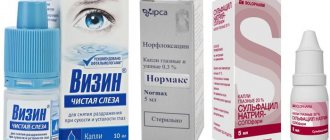Basic information about the drug
Available in the form of ear, intranasal and eye drops. 5 ml bottle. costs 75-80 rubles, and for 10 ml. you will have to pay about 100 rubles. The composition of intranasal and eye drops includes glucaminopropyl carbacridone, which quickly and effectively kills viruses that have entered the body, and also stops inflammatory processes and accelerates the regeneration process. Among the main components of Anandin for the ears is gramicidin, an antibiotic that acts by destroying the protective walls of pathogenic bacteria.
Note! Despite the fact that the compositions of the drops differ only slightly, using the same drug for the ears and eyes is prohibited. Otitis drops are too aggressive for the sensitive membrane of the eyes. But the intranasal form of the drug can also be instilled into the cat’s eyes.
Anandin eye and intranasal drops 5 ml
INSTRUCTIONS
on the use of the drug Anandin eye and intranasal drops
COMPOSITION AND FORM OF RELEASE
The drug contains glucoaminopropylacridone (2%) and auxiliary components: glycerin 5%, water for up to 100%. They are produced in 5 ml glass bottles, sealed with rubber stoppers, reinforced with aluminum caps. The bottles are individually packaged in cardboard boxes along with instructions for use.
PHARMACOLOGICAL PROPERTIES
Anandin eye drops and intranasal drops have anti-inflammatory, antimicrobial and regenerative effects. Glucaminopropylcarbacridone, which is part of the drops, belongs to the group of low-molecular-weight cytokine inducers and has anti-inflammatory and wound-healing effects.
Glucaminopropylcarbacridone stimulates the production of endogenous interferon, increases the functional activity of T-lymphocytes and macrophages, and activates the production of pro-inflammatory cytokines.
In terms of the degree of impact on the body, Anandin eye drops and intranasal drops are classified as low-hazard substances (hazard class 4 according to GOST 12.1.007-76). The drug does not have a locally irritating, resorptive-toxic or sensitizing effect.
INDICATIONS
Anandin eye drops and intranasal drops are used to treat conjunctivitis and rhinitis in dogs and cats.
DOSES AND METHOD OF APPLICATION
For conjunctivitis, the drug is instilled 2-3 drops into the lower eyelid twice a day, for rhinitis - 2-4 drops into each nasal passage two to three times a day. Treatment is carried out until the animal recovers. The course of treatment is 5-7 days, in rare cases - 10-14 days.
SIDE EFFECTS
When using the drug according to the instructions, side effects and complications, as a rule, are not observed. In case of individual hypersensitivity of the animal to the active components of the drug and the occurrence of side effects, the use of the drug is stopped and, if necessary, antihistamines are prescribed.
CONTRAINDICATIONS
Increased individual sensitivity to the active components of the drug.
SPECIAL INSTRUCTIONS
Features of the action when starting to take the drug and when stopping it have not been established.
When working with Anandin eye and intranasal drops, you should follow the general rules of personal hygiene and safety precautions provided for when working with medicines.
STORAGE CONDITIONS
The drug is stored in a dry place, protected from light, inaccessible to children and animals, separately from food and feed at a temperature of 0 to 25 ° C. The shelf life of the drug, subject to storage conditions, is 24 months. The drug should not be used after the expiration date.
Indications for use
Otitis, rhinitis and conjunctivitis can develop simultaneously if a respiratory infection enters the body. If the animal suffers only from rhinitis and conjunctivitis, then it is likely that the cause is an allergic reaction. Despite the fact that in most cases the problem can be solved with drops alone, it is better to first consult with a veterinarian and determine the exact cause of the disease. It is likely that the doctor will be able to advise non-drug methods to solve the problem.
Interesting to know! Cats are ten times less likely to suffer from ear and eye problems than dogs. This is due to the fact that representatives of the cat family lead a more closed lifestyle and go outside less often.
It is worth paying close attention to the health of the cat if it is not vaccinated and has been outside for a long time; came into contact with sick animals. In the early stages of the disease, symptoms of infection may not be obvious, but it is important to begin treatment at this stage. Otherwise, complications may develop in the form of deterioration in vision, hearing, and smell. In advanced cases, minor inflammation can result in complete blindness and deafness.
It is recommended to show the animal to a doctor and administer a prophylactic dose of Anandin if:
- the cat rubs its ears, blinks frequently;
- excessive tearing is observed;
- abnormal discharge appears from the ears, eyes, nose;
- redness on the cornea is clearly visible;
- the animal is breathing heavily.
If it is not possible to contact a veterinarian as soon as possible, then if the above symptoms appear, you need to examine the cat yourself. If any abnormalities are clearly visible, you can instill a prophylactic dose of Anandin (2 drops into each eye, nasal passage or ear canals). However, it is necessary to understand that such treatment is used only to alleviate the condition. Only a doctor can prescribe a truly effective course of therapy.
Instructions for use of drops
In order to completely cure the disease, you will have to instill Anandin three times a day for a week. However, the timing of therapy and dosage can be changed by the veterinarian, depending on the initial condition of the animal.
The burying process can be complicated by the animal's temperament. The cat may scratch, pull out and bite. This significantly increases the risk of dripping drops past the affected area. To treat the nose and ears, you need to sit your pet on your lap and grab the head between your elbow and forearm. To prevent the animal from scratching the skin, it is best to wear a thick jacket and pants. If your pet actively tosses and turns, then it is worth swaddling it in a blanket so that its paws remain immobilized.
If you only need to treat otitis media, then you only need to remove the cap and insert the tip of the dropper into the animal’s ear. For greater comfort for your pet, the instructions recommend preheating the bottle with drops in your palms.
Note! Intranasal and eye drops are available in bottles without a nozzle, so you will have to prepare a pipette in advance. This slightly complicates the application process.
To drop the medicine into the eyes and nose of a cat, you will have to draw the medicine into a pipette in advance and only then immobilize the animal. Usually the pet tries to squint, or may even close its eyes. Therefore, it is recommended to create dim lighting in the room (if it is not possible to adjust the brightness of the light, then you can simply cover the lamp with a cloth). If the animal stubbornly refuses to open its eyes, you can open the eyelids yourself (after washing your hands). And to instill the medicine into the nose, it is enough to firmly hold the cat’s face in your palm.
You can now view the current price of the drug and buy it right here:
Anandin eye and intranasal drops for cats and dogs, 5 ml bottle
Anandin eye and intranasal drops for cats and dogs, 5 ml bottle
Drops for the treatment of conjunctivitis and rhinitis in dogs and cats.
General information:
1. Trade name of the drug: Anandin eye and intranasal drops. The international nonproprietary name of the active substance is glucaminopropylcarbacridone.
2.Dosage form: eye and intranasal drops. Anandin contains glucaminopropylcarbacridone-2% as an active ingredient, glycerin - 5% and water for injection - up to 100% as excipients. In appearance, the drug is a transparent liquid of light green color.
3. Anandin drops are produced packaged in 5 and 10 ml bottles made of neutral glass, sealed with rubber stoppers reinforced with aluminum caps. Each bottle is packed in cardboard boxes along with instructions for use.
4. Store the medicinal product in the manufacturer’s sealed packaging in a dry place, protected from direct sunlight, separately from food and feed, at a temperature of 5 to 25 C. The shelf life of the drug, subject to storage conditions, is 2 years from the date of production. It is forbidden to use anandin drops after the expiration date.
5. Drops should be stored out of the reach of children.
6. Unused medicinal product is disposed of in accordance with legal requirements.
Pharmacological properties:
7. Glucaminopropylcarbacridone (anandine), which is part of the drops, belongs to the group of low-molecular cycotine inducers and has anti-inflammatory, anti-infective and wound-healing effects. Glucaminopropylcarbacridone stimulates the production of endogenous interferon, increases the functional activity of T-lymphocytes and macrophages, and activates the production of anti-inflammatory cycatins. In terms of the degree of impact on the body, Anandin is classified as a low-hazard substance (hazard class 4 according to GOST 12.1.00-76). The drug does not have a locally irritating, resorptive toxic or sensitizing effect.
Directions for using the drug:
8.Anandin eye drops and intranasal drops are used in the complex therapy of conjunctivitis and rhinitis of various etymologies in dogs and cats.
9. A contraindication to the use of the drug is the increased individual sensitivity of the animal to the components included in the drug.
10. For conjunctivitis, the drug is instilled 2-3 drops behind the lower eyelid twice a day. For rhinitis - 2-4 drops in each nasal passage two to three times a day. Treatment is carried out until the animal recovers. But no more than 14 days. During treatment with the drug, no special conditions for keeping and feeding animals are required.
11. No overdose symptoms have been identified when using the drug.
12. Peculiarities of action when starting to take the drug and when stopping it have not been established.
13. In case of non-compliance with the established period of repeated treatments, the use of the drug should be resumed in the same dosage according to the same scheme.
14. As a rule, there are no side effects or complications when using Anandin drops in accordance with these instructions. If the animal’s individual sensitivity to the active components of the drug is increased and signs of severe irritation appear, the use of the drug is stopped and, if necessary, antihistamines are prescribed.
15.Anandin drops are compatible with other medications and feed additives.
16. Since the drug is intended for non-productive animals, the terms of possible use of products of animal origin are not regulated.
Personal prevention measures:
17.When working with the drug, you should follow the general rules of personal hygiene and safety precautions provided for when working with medicines. After finishing work, wash your hands with warm water and soap.
18. In case of accidental contact of the medicinal product with the skin or mucous membranes of the eyes, they must be rinsed with plenty of water. People with hypersensitivity to the components of the drug should avoid direct contact with Anandin drops.
19. Empty bottles of medicinal products must not be used for household purposes; they must be disposed of with household waste.
Manufacturer:
LLC NIO "Mediter", Russia
Tips for increasing efficiency
Some reviews about Anandin for cats say that treatment with drops lasted for weeks, but no improvement occurred. Veterinarians admit that the reason for such prolonged therapy may be either the use of an expired product or a violation of basic hygiene rules. For example, the remedy will be absolutely useless if instilled directly into pus. Therefore, the first thing to do is clean the treated area. To do this, just apply regular saline solution to a cotton swab and wipe your eyes or ears. This simple action will allow the active components of Anandin to reach the affected mucous membranes directly.
Advice! When instilling eye drops, you need to pay attention to ensure that the tip of the pipette does not scratch the cornea, but is at least 1-2 mm higher. It is best to point the dispenser at the inner corner of the eye. When you blink, the medicine will spread throughout the entire area of the sclera.
Veterinarians also say that it is necessary to pay attention to completing the procedure. Even if the cat sat quietly and allowed the required amount of medication to be instilled, insufficient attention from the owner after completion of the treatment process can negate all the positive results.
The following rules must be adhered to:
- Do not let the animal out of your hands for 10-15 minutes after completing the procedure. Almost all animals that received the medicine, immediately after being released from the owner’s hands, begin to rub their ears/nose on the floor or try to touch their eyes with their paws. In order for the medicine to take effect, it is recommended to hold your pet in your arms for at least 10 minutes.
- Do not try to massage the inner surface of the ears or eyes for “better absorption” of the medicine. It is likely that the animal will enjoy the impromptu massage, but the speed of action of the medicine will not change. But the probability of spreading the remaining pus is quite high.
- Give the cat a treat. So that the animal is not afraid of the next procedure and does not hide every time the owner picks up a bottle of medicine, it is necessary to prepare a treat. You can give veterinary vitamins with an attractive aroma.
Side effects and contraindications
Despite the fact that the manufacturer indicates that there are no side effects from the use of Anandin, veterinarians recommend carefully monitoring the behavior of the treated pet. If the animal blinks frequently and rubs its muzzle on the floor within fifteen minutes after the procedure, then this is considered normal. But if this behavior continues for more than an hour, and there is also redness of the skin and a rash, then it is necessary to immediately consult a veterinarian. It is likely that your pet is developing an allergic reaction. An antihistamine can be given as first aid.
Reviews about Anandin drops for cats
Angelina, 29 years old:
“I bought a British kitten. I studied the characteristics of the breed for a long time and was prepared for the fact that in the first year of its life my pet’s eyes would become watery. At first I treated the kitten with saline solution, but over time I noticed that the eyes began to not only water, but also fester. The veterinary pharmacy advised me to give Anandin. Since the price of the product did not exceed 100 rubles, I decided to try it. After just two treatments, the pus began to go away. After about a week all the problems stopped.”
Konstantin Viktorovich, veterinarian:
“I prescribe Anandin quite often. The drug is inexpensive, so animal owners do not try to dilute it or replace it with something else. However, for rhinitis, I try to choose another remedy, since many of my clients complained of excessive salivation and even vomiting after instilling medicine into the pet’s nose. There are no such problems when treating ears and eyes.”
Pros and cons of the drug
Compared to other veterinary drugs with similar properties, Anandin has a number of advantages, including:
- the ability to be used in the treatment of various pathologies;
- no side effects or overdose (if instructions are followed);
- no contraindications for pregnant and lactating cats and kittens;
- affordable cost and availability in almost all veterinary pharmacies;
- several dosage forms, which allows you to choose the most convenient one for different diseases;
- compatibility with all medications, which allows, if necessary, to use the drug simultaneously with other medications.
Anandin has the only drawback - it is prohibited from long-term use. But, as veterinarians note, this medicine is so effective that there is practically no need to extend the therapeutic course.
Solution for injection Anandin
Anandin aqueous solution intended for injection is produced in the form of a clear green liquid. The main active component, as in the drops, is glucaminepropylcarbacridone. The content of the active substance in the solution is 10%. It also contains an excipient called methylene blue, which has antiseptic properties.
The solution has a slight specific odor. For its packaging, glass ampoules are used, which are hermetically sealed. The capacity of each ampoule is 2 ml. Ampoules are packed in 3 pieces in cardboard boxes. The cost of such packaging ranges from 155-170 rubles. In some pharmacies, ampoules are sold individually (60-70 rubles per piece).
When and how to use
The drug has an immunostimulating, antiviral and anti-inflammatory effect. It is usually prescribed to cats as part of complex therapy for the treatment of viral infections:
- plague;
- parvovirus enteritis;
- viral hepatitis, etc.
Also, the drug can be used to treat complications of bacterial origin that arose against the background of infectious diseases. The use of Anandin is allowed to be combined with antibiotics, hormonal agents, serums and medications aimed at relieving symptoms.
Injections of the solution are made intramuscularly. The dosage is calculated according to the following scheme: 0.15-0.2 ml per 1 kg of weight. If the disease is at an early stage, it is necessary to give injections once a day for 3 days. If the pathology is severe, then the course of treatment can be increased to 6 days, but only a doctor should determine the duration of treatment.
Note! Anandin injections should not be given if you have kidney failure.
Description of the drug
Anandin eye drops and intranasal drops are available in the form of a transparent solution, the shade of the solution is light green. The main active ingredient of the drug is glucaminopropylcarbacridone (or anandin). Its quantitative content in 1 ml of solution is 20 mg.
Anandin drops are used in veterinary medicine
Read about how conjunctivitis develops and is treated in people.
Anandin is the main active ingredient in eye and intranasal drops. Another name for the component is glucaminopropylcarbacridone.
The main excipients are glycerol and distilled water. Drops are sold in glass bottles with rubber stoppers. The drug can also be purchased in the form of an injection solution with a concentration of the active substance of 10%. The solution has a greenish tint and a specific weak odor. Excipients used in the production of this form of the drug are distilled water and methylene blue. Solutions for injection are supplied in glass ampoules of different volumes (1, 2 and 5 ml), as well as vials (5, 10 and 100 ml).
How to put drops in the eyes of animals
Each ampoule of Anandin must be labeled and contain information about the volume, expiration date, batch number, and name of the drug.
Ointment for external use
Externally, the ointment has a pasty consistency of light yellow color. There is a slightly pronounced specific odor. It is packaged in small polymer jars. Each container holds 10 g of medicine. The content of glucaminopropylcarbacridone is insignificant - only 2%. The composition also contains excipients:
- Castor oil;
- petrolatum;
- purified water;
- potassium salicylic acid.
The price of the medicine is 45-60 rubles per jar.
The drug is a low-hazard substance, but it has a wide spectrum of action:
- increases immunity;
- stimulates tissue regeneration;
- prevents the development of infections;
- relieves symptoms of injuries.
Features of use
The ointment is used to treat injuries and pathologies of the skin of various origins:
- cuts and wounds;
- burns;
- dermatitis;
- eczema, etc.
The medicine is applied in a thin layer to the affected area. Depending on the degree of the disease and the severity of the injury, the procedure is carried out 1-3 times a day. Before reapplying the ointment, the area of skin affected by the pathology is washed with saline and, if necessary, treated with antiseptics. The duration of treatment can last from 4 to 7 days. Do not use the ointment only if you are intolerant to the components. The medicine has no other contraindications.
How to use Anandin
The use of the drug depends on the form of release. The manufacturer includes instructions for use in the packaging. The pet owner is advised to read this document.
Ear drops
The treatment procedure begins with a thorough cleaning of the pet's ears. To do this, moisten a cotton swab with Anandin or saline solution and wipe the inner surface of each ear. You should not try to penetrate too deeply into the auricle, as you may damage the eardrum. Regardless of whether the cat is bothered by both ears or only one, the medicinal composition should be dripped into each. Single dose - 3-4 drops.
In order for the drops to be distributed over the entire inner surface of the ear, you need to lightly massage the auricles. If the medicine gets on the animal's fur, it is recommended to wipe the area with a napkin.
The treatment course with Anandin drops lasts 1 week. It is enough to instill the drug once a day. But before starting therapy, you should consult a veterinarian. The specialist, after conducting diagnostic procedures, will select the correct treatment.
External remedy
Before using the ointment, there is no need to cut the hair or remove dry crusts. The medicine is applied in a thin layer to the affected area, covering another 2-4 cm around. The procedure is repeated up to 3 times a day. Before each subsequent application of the ointment, the skin should be treated with an antiseptic. But you must act carefully so as not to injure the affected area.
The duration of therapy with Anandin ointment is 4-7 days, depending on the degree of damage to the dermis. After the full course, the skin cleanses and hair begins to grow.
During the treatment period, it is better not to let the cat go outside, as sunlight negatively affects the effect of the drug. Owners are advised to monitor the behavior and general condition of the pet. If any abnormalities occur, you must show your cat to a doctor.
Eye drops
Before instilling the medicinal composition, you must carefully rinse your pet's eyes. Water or weak tea leaves are suitable for this. After washing, begin instillation. For convenience, the bottle is equipped with a dropper. Apply 2 drops under the lower eyelid of each eye.
This is done in the morning and evening. The length of treatment depends on how affected the cat's eyes are. But most often 5 days are enough. Sometimes the duration increases to 1 week. The veterinarian will give you more precise timing.
These drops are also used to treat inflammatory pathologies of the nasal cavity. Veterinarians advise putting 2-4 drops into each pet’s nostril in the morning, at lunchtime and in the evening. The duration of the course depends on the condition of the cat.
It is not recommended to use drops for more than 2 weeks. This applies to the treatment of both eyes and nose. If there is no improvement, you need to show the cat to the veterinarian.
Injection
The amount of solution for injection is calculated individually. The dosage depends on the weight of the cat and the purpose of administration:
- for treatment - 20 mg per 1 kg of body weight;
- for prevention - 5 mg per 1 kg of body weight.
The calculated dose is injected once a day into the muscle. If the pet is sick and needs treatment, injections are given for 3 days. The preventive course lasts 10 days.
For injections, only sterile syringes are used. Antiseptic requirements must be observed.
Owner reviews
Julia, owner of a cat and 2 dogs:
“I have been using Anandin injections for a long time to treat any intestinal infections. Usually 2-3 injections are enough to completely get rid of unpleasant symptoms. I have repeatedly used it for both cats and dogs, so I can attest to the effectiveness of the medication.”
Alexandra, owner of a British cat:
“Our cat’s purulent wound did not heal for almost 2 months until the veterinarian prescribed Anandin ointment. A 5-day course was enough for the wound to heal completely. Inexpensive product. Easy to use. Works well. Safe for cats."
